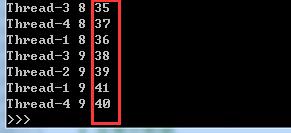python 多线程笔记-- 锁
Posted
tags:
篇首语:本文由小常识网(cha138.com)小编为大家整理,主要介绍了python 多线程笔记-- 锁相关的知识,希望对你有一定的参考价值。
锁是什么?什么场合使用锁?
锁是一种机制,用于保护那些会引起冲突的资源。
比如上厕所,进去之后第一件事干嘛?把厕所门反锁!表示什么呢?表示这个厕所正在使用中!
至于在厕所里面干大事、干小事、还是打飞机,都可以!
完事之后干嘛?把厕所门打开!表示什么呢?那谁,你可以进来打飞机了。
一、全局锁、函数内部上锁/解锁、函数打包进线程
import threading import time def my_func(num): global counter, mutex # 获得线程名 threadname = threading.currentThread().getName() for i in range(num): mutex.acquire() # 锁住① counter = counter + 1 # 保护② 如同厕所坑位是抢占性资源,同一时间只能一个人去蹲 mutex.release() # 解锁③ print(threadname, i, counter) # 再回去,坑位counter可能已被其它人蹲过 time.sleep(1) if __name__ == ‘__main__‘: counter = 0 # 计数器 mutex = threading.Lock() # 创建锁 threads = [] for i in range(4): threads.append(threading.Thread(target=my_func, args=(10,))) # 创建线程 for t in threads: t.setDaemon(True) # 守护 t.start() # 启动线程 for t in threads: t.join() # 阻塞主程,直到线程退出
运行效果图:

可以发现到 counter 并不是顺序显示的,看官可以思考其原因。
二、全局锁、线程类、线程类run方法中上锁/解锁
import threading import time class Worker(threading.Thread): ‘‘‘线程类‘‘‘ def __init__(self, num=5): super().__init__() self.num = num def run(self): global counter, mutex threadname = threading.currentThread().getName() for i in range(self.num): mutex.acquire() # 锁住① counter = counter + 1 # 保护② 如同厕所坑位是抢占性资源,同一时间只能一个人去蹲 mutex.release() # 解锁③ print(threadname, i, counter) # 此时,counter可能又已被其它线程改变 time.sleep(1) if __name__ == ‘__main__‘: # 全局计数器 counter = 1 # 创建锁 mutex = threading.Lock() # 创建线程对象 threads = [] for i in range(4): threads.append(Worker(10)) # 添加 4 个 Worker # 启动线程 for t in threads: t.start() # 阻塞主程 for t in threads: t.join()
以上是关于python 多线程笔记-- 锁的主要内容,如果未能解决你的问题,请参考以下文章